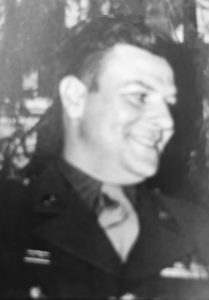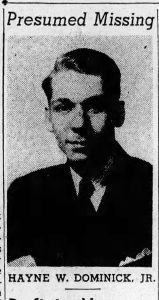For the past three weeks, we have followed the lives of local heroes Private Camden Bryant, 2nd Lt. Stanley Aaron, Private Hayne Dominick, Jr., and Private Ralph Jefferson Turner, Sr. as they were forced to leave the Philippines, endure the Bataan Death March, and nearly three years in Japanese prisoner of war camps. We will conclude the series this week with the story of another local hero, James Walter Trent.

Private James W. Trent grew up between Patrick Springs and Critz, the son of Walter Cole Trent and Nannie Virginia Witt Trent, the paternal grandson of Abe Trent and Nancy Spencer Trent, and the maternal grandson of Charles Richard Witt and Nancy Reynolds Witt of the Carter’s Store area of Henry County.
Hayne Dominick, Jr. recorded Private James Trent’s story and Trent allowed him to share it. Hayne, “Trent left the United States on October 23, 1941, with the 803rd Engineers, and he fought on Bataan at the same place where Camden Bryant and I were stationed. We were all at Agaloma Point during that 14-day battle, though we did not know Trent at the time and were not to know him for some time yet. Trent was assistant squad leader of a squad of ten men that went through some of the fiercest fighting at Agaloma, and he was one of only three of the ten men who survived in the jungle.”
“During the height of the battle, Trent’s outfit went three days and nights without food, sleep, or water. Some of the men were forced to drink the water from their machine guns and it made them very ill. Trent and the other survivors were withdrawn in February to Corregidor where they hoped to hold out under General Jonathan Wainwright, but they were forced to surrender on May 7th, 1942.”
The following part of this story is in James Trent’s words, retold to Hayne Dominick, Jr. and Kay Thompson. “One day I was assigned to dig a latrine at Camp Cabanatuan. One of the fellows next to me was talking about Virginia and he asked if I recalled the song, ‘The Trail of the Lonesome Pine?’ He began talking about the pretty pine trees on the Blue Ridge Mountains. One of the other boys was talking about Virginia and asked me where I was from and he told me he was from Martinsville, Virginia. I thought that I had recognized him and sure enough I did. His name was Camden Bryant.”
Hayne picks up the story, “Trent said he remembered Camden’s face, having seen him once or twice when Camden was working for Joyce’s Barber Shop. Camden brought Trent around to see me, and then they looked up Ralph Turner from Patrick County, and I introduced Trent to Stanley Aaron. We became great friends, all of us.”
Hayne recounts what James Trent shared with him, “The Japanese caught a starving Trent stealing a pepper from the garden. The Japanese took him into camp, placed him where most of the Americans could watch, and each of the 25 guards on duty struck him five times each with their rifle butts. The guards took the rifles by the barrels and swung them like baseball bats, with 125 blows knocking him into insensibility. Before they administered the beating, they forced Trent to stand for four hours, from 8 a.m. to 12 noon, in the glaring sunlight with his hands outstretched above his head. When his strength failed and his hands fell, a Japanese guard would walk up to him and slap his face until his hands reached heavenward again. After the beating, the Japanese locked Trent in the guardhouse for 14 days. After his release, the Japanese guards gave Trent .68 cents and told him to buy himself some peppers.”
Trent shared another horrific event with Hayne and Kay Thompson, “One day, some of the Japanese guards came into the garden and saw where some pumpkins had been cut off the vines. Some other Japanese had taken the pumpkins, but they blamed us. They found two pumpkins as big as water buckets, handed them to me and another fellow, made us climb aboard a log, and forced us to hold those pumpkins for 16 solid hours. We were forced to hold them over our heads for 30 minutes, then we could hold them in cupped arms for another 30 minutes. After that, we were allowed to rest for 30 minutes, still standing on the log, until the process started over again. I believe this was the hardest thing that I ever had to do.”

Trent was moved to Ashio, a copper mining town 60 miles north of Tokyo, where he worked for five months, before being sent to Shinegowa hospital, a Japanese “guinea pig” station in Tokyo. He was sent to the hospital because he was injured in a mine cave-in and was also suffering from beri-beri. Trent and a number of American boys endured different medical experiments. In Trent’s case, Vitamin C was injected into his spinal fluid every other day. Trent stated, “It was a miserable life. I thought that I would die each day, but all I could do was lie there and suffer from those shots. A lot of the Americans did die from the experiments, and that made us worry even more.” Trent lost 70 pounds in three months; next came the B-29 bombing raids. On one occasion, three bombs struck the camp where Trent was hospitalized. Private James Walter Trent was finally liberated on August 29th, 1945. Trent was sent to Woodrow Wilson Hospital in Staunton, Virginia where he underwent treatment for the horrible beatings he endured, the diminishing eyesight from the lack of vitamins, and beri-beri in his legs. Trent returned to Patrick County, married, and had four children. James W. Trent died at the very young age of 44 and was buried at Roselawn Cemetery.
Hayne Dominick, Jr. was promoted to Sergeant, married a Patrick County girl, Miss Betty Ruth Critz, and became a successful businessman in Martinsville, Virginia. He passed away in 1995 at the age of 75 and was buried at Oakwood Cemetery in Martinsville.
After recovering from extremely bad burns, Ralph Jefferson Turner, Sr. returned to Patrick County where he married and had several children. Ralph passed away in 1990 at the age of 68 and is buried at Sycamore Baptist Church Cemetery in Buffalo Ridge/Woolwine.
28-year-old Private Camden Bryant’s and 26-year-old 2nd Lt. Stanley Aaron’s remains lie in the South China Sea where their two separate prisoner of war ships went down. Bryant’s family erected a memorial stone for Camden at Roselawn Cemetery and Aaron’s family placed a memorial stone for Stanley at Oakwood Cemetery.
A poem by Susan Helene Kramer seems to say it best….
Freedom’s Call
We show our thankfulness in prayer
This honor you deserve
Giving all for freedom’s call
That we may live without reserve.
Woody may be reached at rockcastlecreek1@gmail.com or (276) 692-9626.




